Analogous estimating is a popular estimation technique used by project managers across industries. This technique looks at previous similar projects to create project estimates.
In this comprehensive guide, you’ll learn:
- What analogous estimating is
- How accurate analogous estimating is
- Four types of analogous estimating
- Real-life examples of analogous estimating
- Pros and cons of analogous estimating
- How to do analogous estimating
- And more!
Let’s dive in.
What is analogous estimating?
Analogous estimating is a technique that uses information from similar past projects to estimate the project parameters of a new project or task. You can estimate project parameters such as scope, cost, budget, and project duration using analogous estimating.
It’s a simple way to get a rough estimate based on past data.
You can use analogous estimating in the initial stages of your projects when you have limited information about a project.
But, you might ask — is this estimating method accurate?
How accurate is analogous estimating?
Analogous estimating is a quick but rough estimate of a project’s time or cost.
Why?
Because it relies on general similarities and misses specific details. Even similar projects can differ when it comes to details. Because analogous estimation ignores the details, sometimes the estimates can be off.
That’s why analogous estimates are best in the early project planning stages to get a general idea of your project’s cost.
If you need to create exact budgets or a detailed project schedule, look for more accurate methods like bottom-up estimating.
Types of analogous estimates
Let’s look at the four types of analogous estimating techniques.
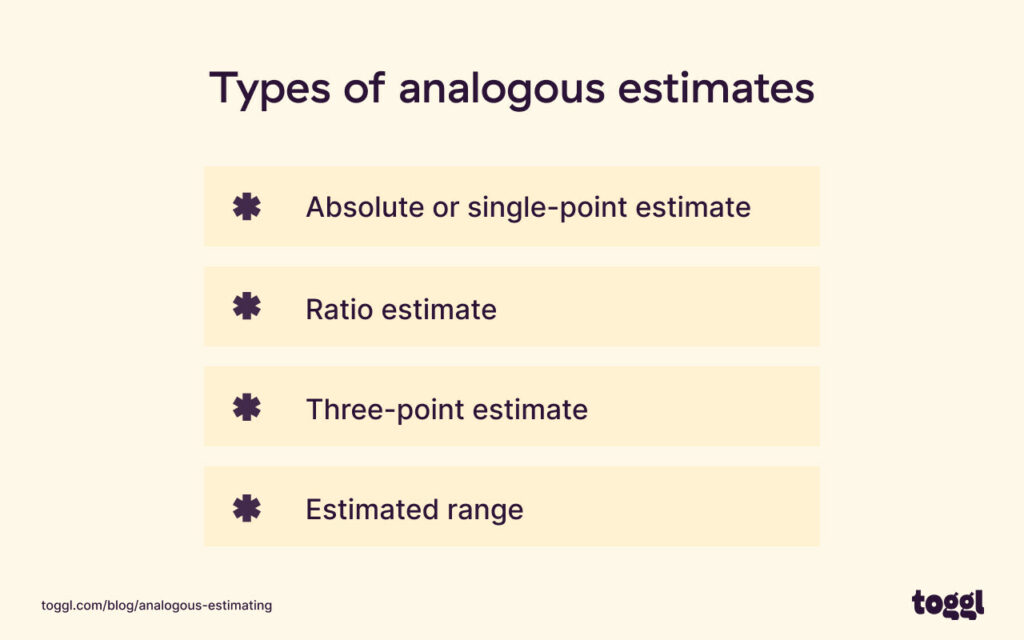
Absolute or single-point estimate
Single-point estimates provide just one value estimate (e.g., “this task will take 6 days”) based on similar tasks or projects in the past.
For example, imagine you spent $5,000 on your last marketing campaign and it rocked.
So, for the next campaign, you estimate the same cost, i.e., $5000.
It’s quick and easy, but not much room for something new or unexpected.
Ratio estimate
This ratio is based on a known ratio from a similar past project. You can think of ratio estimates like slicing up a pie.
Let’s say you know that social media ads ate up 30% of your project budget in past projects. Using the ratio estimation technique, you determine that a new campaign with a $7000 budget, will need $2100 for social media ads.
Estimated range
As the name suggests, you estimate the lower and higher ends of a project’s budget or time, again based on past experience.
For example, instead of a single-point estimate, you estimate a range, like $1000 to $3000.
This method gives you flexibility and options, You’re committed to one number and have room for adjustment.
Three-point estimate
Three-point estimates are based on three estimation points:
- The most optimistic estimate
- The most pessimistic estimate
- The most likely estimate
For example, say you’re planning a new ad campaign. Based on past experience of similar projects, you estimate it will cost between $4000 and $7000, but likely around $5000.
This technique does not provide a single point, but a range and a most likely
estimate.
Examples of analogous estimating
Here are some examples of how analogous estimating techniques might work for agencies.
Example 1
Mary is a project manager at a marketing agency. They have a new client that wants a Google Ads campaign.
She knows the agency had a project with similar requirements last year that cost $8000. So she estimates that this current project costs the same.
This is a quick and single-point estimate, but also rigid. It doesn’t consider that things like ad rates might have changed in a year, or the client’s specific needs might be different.
Example 2
For another marketing campaign, Mary used the three-point estimating method to estimate the cost of this project. She considers three scenarios:
- Best case: It could cost $4000 if everything goes smoothly
- Worst case: It might go up to $6000 depending on variable costs
- Most likely: around $5000 based on past experience
By following this method, Mary is prepared for many outcomes and has a more balanced view of how project costs might change.
Analogous vs parametric estimating
Parametric estimating takes historical information and applies mathematical formulas to project parameters to develop estimates.
Compared to analogous methods, parametric estimating:
- Is more accurate as it uses statistical analysis
- Requires detailed project information
- Is more time-consuming but also more efficient
- Is better for detailed planning
Both methods have their place. If you want a rough estimate, analogous techniques are fine. If you need accurate estimates, then parametric estimating is a better choice.
Consider the difference between a quick sketch and a detailed drawing. Both can be useful, but they serve different purposes.
Advantages and disadvantages of analogous estimating
Let’s see the advantages of analogous estimating and where it might fall short.
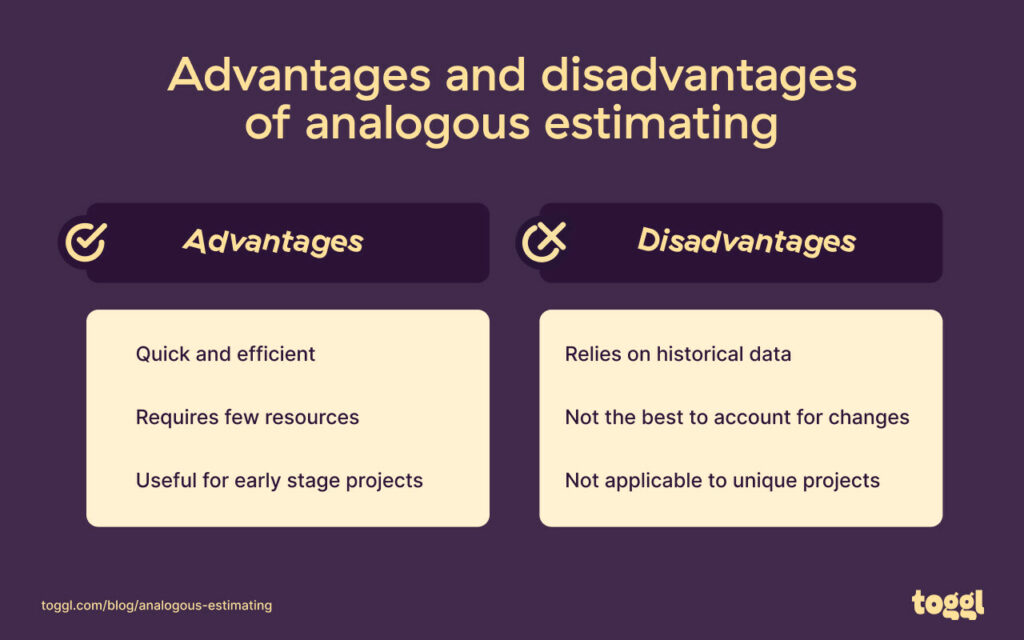
Advantages
- It’s quick and efficient: Analogous estimating doesn’t take much time. If you need an estimate fast, this is the way to go.
- Requires few resources: You don’t need a lot of data or fancy tools for this method. It’s all about using what you already know from previous projects, so it’s budget-friendly.
- It’s useful for early-stage projects: When you’re just starting out and need a rough idea, this method shines. It helps you get the ball rolling without losing time with specifics.
Disadvantages
- It relies on historical data: Analogous estimating uses old info. If that information is wrong or outdated, your estimates will be off.
- It doesn’t account for changes: If things have changed since the past reference project, analogous estimates won’t give you an accurate picture.
- It does not apply to unique projects: If you don’t have data from past projects or the new project is something you’ve never worked on before, analogous estimating won’t work.
Uses of analogous estimating in project management
Let’s look at how you can use analogous estimating across different project stages.
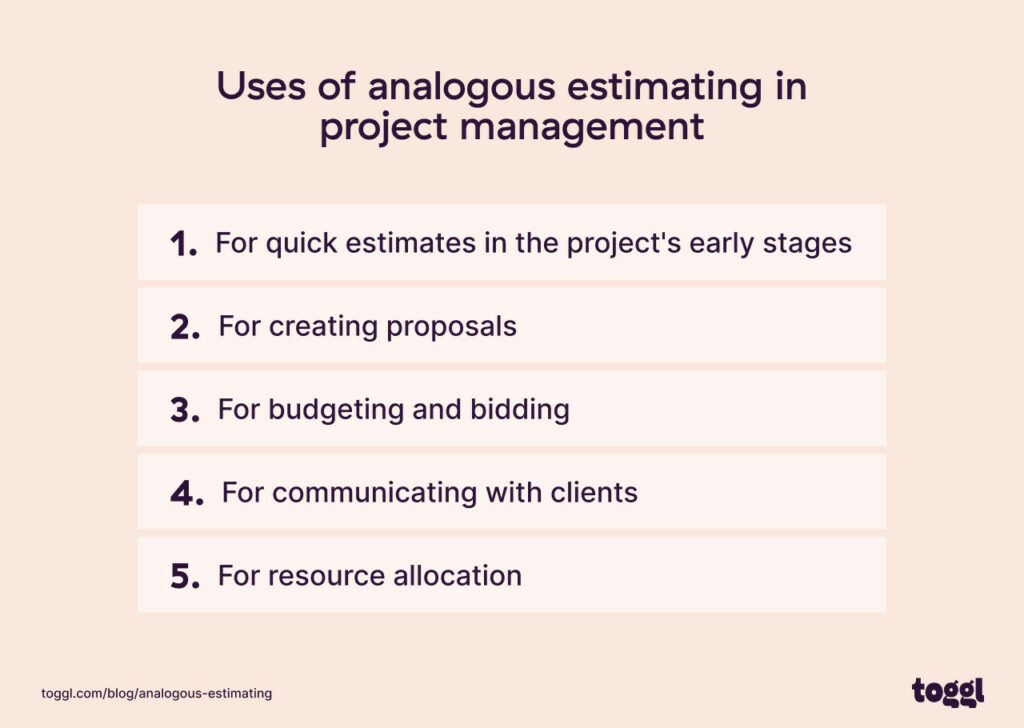
1. Quick estimates in the early stages of a project
When you’re just kicking things off, analogous estimating helps you make a rough guess without spending a lot of effort.
This gives the team a starting point and helps set client expectations early on. It’s not a final estimate, but a preliminary view to get the project moving in the right direction.
2. When creating proposals
Need to pitch an idea to a client? Analogous estimating lets you use what you learned from similar past projects to draft your proposal.
Use it to quickly figure out budgets, timelines, or resources to make your proposal more realistic and convincing.
Analogous estimating is a handy tool for whipping up proposals that people are more likely to say yes to, without starting from scratch every time.
3. For budgeting and bidding
Analogous estimating is a time-saver when you need to set a budget or make a bid.
It lets you take what you’ve spent on similar projects before, and use that information to develop a smart estimate.
With analogous methods, you can quickly come up with a reasonable price estimate for a project.
4. Communicating estimates with clients
Analogous estimating helps when you need to explain project costs to clients. Using data from past projects, you can provide a ballpark figure quickly, offering them an idea of what they might expect.
It’s also useful to estimate costs for change requests from clients.
This way, you take the guesswork out of the conversation and make it easy for clients to understand if something is feasible or not.
5. During resource allocation
Analogous estimating can help you book resources for a specific duration based on data from past projects.
If you have a new project that’s similar to an old one, you can guess how many people or materials you’ll need based on what you used before.
This helps you make educated guesses quickly, saving time and effort.
How to do analogous estimating
Now, let’s get to the practical part of analogous estimating.
Below are five key steps to use in your analogous estimating process.
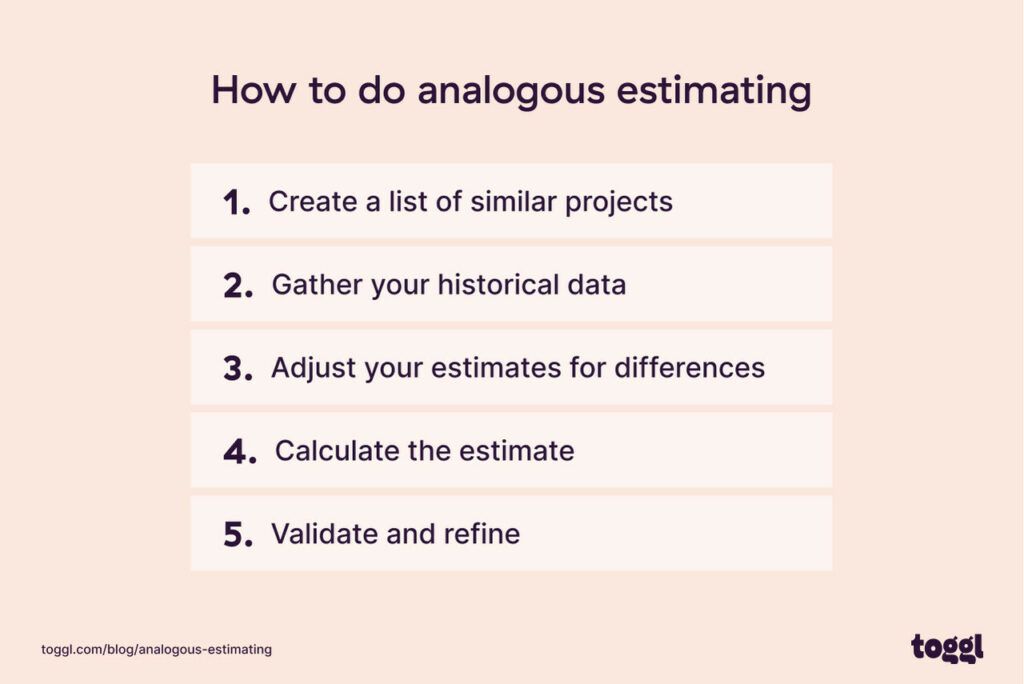
Step #1: Create a list of similar past projects
The first step is to dig up and jot down comparable projects to the one you’re kicking off. You want to look at things like scope, technology, human resources, or complexity.
By making a list of these similar projects, you can see what they need in terms of time, budget, or effort.
This helps you make a quick, smart guess about what your new project might need.
Step #2: Gather your historical data
After you’ve spotted similar projects, it’s time to gather your historical data.
That sounds complicated, right?
Well, not if you use Toggl Track, which makes it easy to visualize how much past projects cost and how long they took.
All you have to do is:
- Log in to your Toggl Track account.
- Go to “Projects”

- See each project’s time and cost.

In the Project Dashboard tab, you can also forecast your budgets and track your progress to get an idea of where your projects are heading.
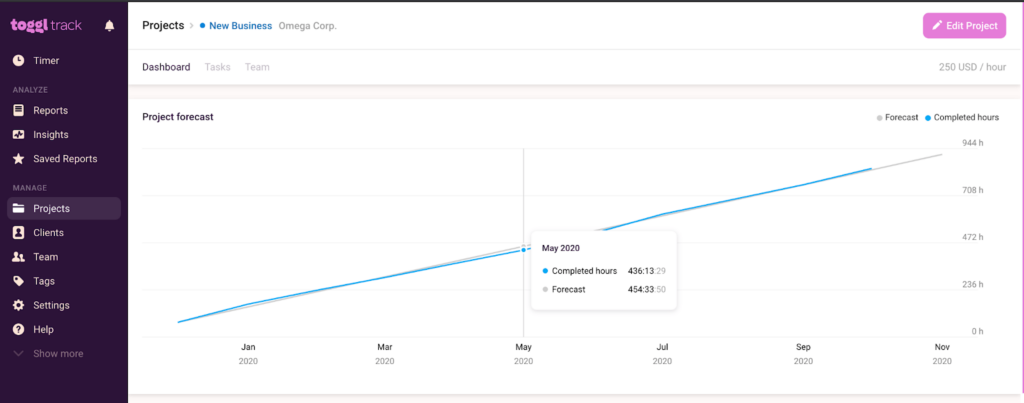
This helps you plan better and spot potential issues early on.
Step #3: Adjust your estimates for changes
Although your projects are similar, they are not identical.
So, your next step is to tweak your estimates to fit the unique parts of your new project.
Maybe your new project is bigger, or it needs different tools, or you need special skills. Whatever the differences are, you’ll need to adjust your estimates based on these changes.
By considering changes, you make your estimates more accurate and realistic.
Step #4: Calculate the estimate
This step is about putting it all together.
You take all the information you’ve gathered and mix it together to come up with an estimate for the entire project.
You consider the time, the resources, the team, and any other factors that might affect the project.
Then, you calculate the final estimate, so you have a clear and accurate picture of what to expect. The final estimate can be based on a type of analogous estimate, i.e.,
- Single-point
- Ratio
- Range-based
- Or Three-point
Step #5: Validate and refine
The final step is to double-check your work.
You take a close look at the entire project estimate and make sure that everything makes sense and adds up.
Ask questions like:
- Does this cost estimate align with industry standards?
- Have we considered all possible expenses?
Based on the answers, you might need to make small adjustments.
Ensure that the estimate is as accurate and tailored to your specific project as possible.
Also, keep in mind that validating and refining the estimate isn’t a one-time thing.
Throughout the project’s lifecycle, you might come back to this step to make sure everything stays on track.
Get better estimates with the right tool
You now know a lot about analogous estimating after reading this guide.
You know that it helps you take the shortcut and create quick project estimates.
You also know that although they are time-saving, analogous estimates are not very accurate.
You need more if you want to create better estimates.
You need a tool like Toggl Track, which can help you come up with more accurate estimates.
But don’t take our word for it. Sign up for a free Toggl Track plan and see it for yourself.
Work tools to elevate your productivity – apps for incredibly simple time tracking and effective project planning.


